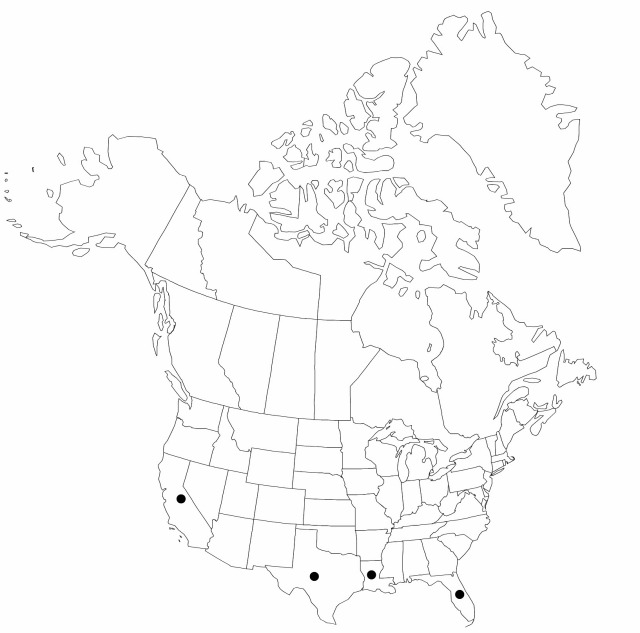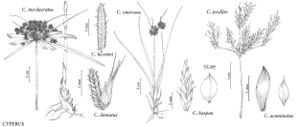Cyperus involucratus
Descr. Pl. Rar., 22. 1772.
Herbs, perennial, cespitose, rhizomatous. Culms trigonous, 30–150 cm × 1–5(–8) mm. Leaves bladeless. Inflorescences: heads digitate, 15–30(–36) mm diam.; rays (14–)20–22, (2–)5–12(–20) cm; 2d order rays 0.3–3(–4) cm; 3d order rays sometimes present, 0.3–2.5 cm; bracts (4–)18–22, ± horizontal, flat, 15–27 cm × (1.5–)8–12 mm. Spikelets 8–20, ovoid to linear-lanceoloid, compressed, 5–25 × 1.5–2 mm; floral scales 8–28, laterally whitish or light brown, ± hyaline, medially light brown, laterally ribless, medially 3-ribbed, 2-keeled in proximal 30–60%, deltate-ovate, 1.6–2.4 × (1–)1.2–1.5(–1.7) mm, apex acute. Flowers: stamens 3; anthers 0.7–1 mm; styles 0.5–1 mm; stigmas 0.6–1 mm. Achenes brown, sessile or stipitate, broadly ellipsoid, 0.6–0.8 × 0.4–0.6 mm, stipe if present to 0.1 mm, apex obtuse, apiculate, surfaces puncticulate.
Phenology: Fruiting early summer–fall.
Habitat: Damp, disturbed soils, ditches, stream banks
Elevation: 0–100(–800) m
Distribution

Calif., Fla., La., Tex., e Africa.
Discussion
Cyperus involucratus has been collected in New York (R. S. Mitchell and G. C. Tucker 1997).
Cyperus involucratus is widely cultivated as a water plant in greenhouses and outdoors in warm-temperate or tropical climates. It has long been misidentified in the flora as C. alternifolius Linnaeus, an endemic of Madagascar (G. C. Tucker 1983).
Selected References
None.
